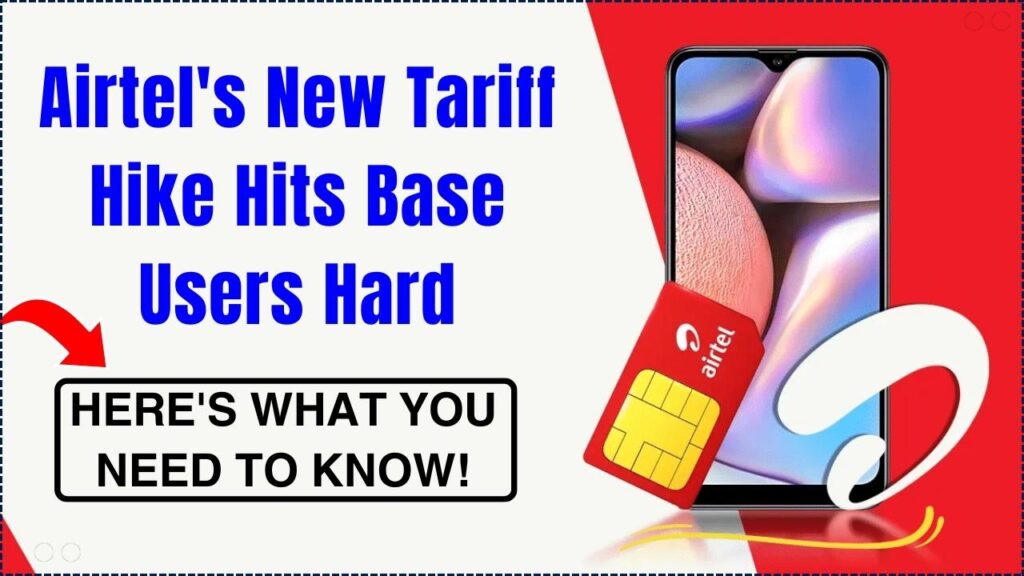
Airtel’s New Tariff Hike Hits Base Users Hard: In January 2025, Bharti Airtel, one of India’s largest telecom providers, introduced a tariff hike that has raised eyebrows and impacted millions of its base users. While the company has positioned this move as a step toward financial sustainability and future investments, the increase in prepaid plans, particularly for entry-level users, has sparked widespread discussion. Whether you’re a professional, a student, or a budget-conscious individual, this change is likely to affect how you plan your mobile expenses.
Airtel’s tariff hike comes at a time when the Indian telecom industry is undergoing significant transformation. The demand for high-speed connectivity, coupled with the rollout of 5G services, has placed immense financial pressure on telecom operators. Airtel’s move, while controversial, aligns with the broader trend of increasing tariffs to support infrastructure growth and enhance service quality.
In this article, we’ll dive deep into the reasons behind Airtel’s tariff hike, how it impacts users, and what steps you can take to manage your mobile expenses effectively. From practical advice to industry insights, this comprehensive guide has got you covered.
Airtel’s New Tariff Hike Hits Base Users Hard
| Aspect | Details | Why It Matters |
|---|---|---|
| New Tariff Plans | Prepaid tariffs increased by 10% for most plans, including entry-level options. | Affects budget-conscious users and increases monthly communication costs. |
| Base Plan Changes | Entry-level plan (previously INR 99) now costs INR 109, offering the same 200MB data and talk time. | Base users face the brunt of the hike, especially those on tight budgets. |
| Industry-Wide Trend | Other telecom operators like Jio and Vodafone Idea are also expected to raise tariffs. | Reflects a broader industry effort to boost ARPU (Average Revenue Per User). |
| 5G Rollout Financing | Funds raised through higher tariffs will support network upgrades and 5G infrastructure expansion. | Ensures better connectivity and technological advancements in the long term. |
Airtel’s tariff hike is a double-edged sword. On one hand, it supports the company’s financial health and ensures the continued rollout of advanced technologies like 5G. On the other hand, it places additional financial strain on base users who rely on affordable mobile plans. By reviewing your plan, monitoring your usage, and exploring alternatives, you can mitigate the impact of this increase and continue to stay connected.
The telecom industry’s shift toward higher tariffs reflects a broader effort to balance affordability with sustainability. While this adjustment may be challenging for some users, it is essential to ensure the industry’s long-term growth and ability to deliver cutting-edge services. Staying informed and proactive will be key to managing these changes effectively.
Why Has Airtel Increased Its Tariffs?
1. Financial Sustainability
Telecom operators like Airtel face increasing costs associated with spectrum purchases, network expansion, and 5G infrastructure rollouts. Airtel’s CEO has repeatedly stated that raising the ARPU to INR 300 is critical to maintaining financial viability and providing adequate returns to investors. The current ARPU stands at INR 200, highlighting the need for incremental hikes to achieve this target.
Airtel’s focus on financial sustainability is also influenced by global market trends. As telecom operators worldwide grapple with rising operational costs, strategies like tariff hikes have become necessary to balance revenue generation and infrastructure investments. Without these adjustments, the company risks falling behind in delivering competitive services and meeting consumer expectations.
2. Industry Competition and 5G Deployment
The race to deploy 5G services across India is a key driver behind the tariff hikes. Airtel has already launched 5G services in major cities, but sustaining this rollout requires substantial capital. With competitors like Reliance Jio also investing heavily in 5G, telecom operators must ensure they remain competitive while meeting the growing demand for high-speed connectivity.
India’s telecom market is one of the most price-sensitive globally, which makes tariff hikes a challenging yet necessary decision. Airtel’s strategy reflects its commitment to providing cutting-edge technology while maintaining financial health in a competitive landscape.
How the Airtel Tariff Hike Impacts Base Users
Entry-Level Plans Get Costlier
Airtel’s entry-level prepaid plans have seen a significant price jump. For instance:
- Old Plan: INR 99 for 200MB data and INR 99 worth of talk time.
- New Plan: INR 109 with the same benefits.
While a 10% increase may seem minor, for users on a tight budget, it adds up over time. Monthly costs for basic communication services now require reevaluation.
Reduced Accessibility for Low-Income Groups
Base users, including students and daily wage earners, who rely on affordable plans, will feel the financial pinch. The increased cost might force many to either reduce their mobile usage or switch to alternative providers. For these groups, even small increases can lead to difficult choices between staying connected and managing other essential expenses.
Impact on Rural Users
The tariff hike disproportionately affects rural users, where access to affordable communication services is vital for economic activities, education, and healthcare. Many rural users rely on entry-level plans, and the increased cost may discourage mobile usage, widening the digital divide.
How to Manage Mobile Expenses Amid Rising Costs
1. Review Your Current Plan
- What to Do: Analyze your usage patterns—data, calls, and SMS.
- Pro Tip: Airtel’s online portal and mobile app provide detailed breakdowns of your usage, helping you identify cost-saving opportunities. For instance, if you primarily use Wi-Fi at home, consider downgrading your data plan to save money.
2. Explore Competitive Options
- Other telecom providers like Reliance Jio and Vodafone Idea may offer comparable plans at slightly lower prices. Comparing plans can help you make an informed decision.
- Warning: Always consider network quality and coverage before switching providers. A cheaper plan may not provide the same level of service, especially in rural or remote areas.
Synopsys Hiring in India: Unlock Amazing Career Paths in Tech!
Synopsys Recruitment Drive in India: Unlock Your Career Potential Now!
H-1B Visa Debate: India Responds, Collaborates with IT Companies for Solutions
3. Monitor Data Usage
- Excessive data consumption often drives up costs. Apps like Google’s Datally or in-built phone settings can help monitor and reduce data usage.
- Switch to Wi-Fi for heavy data activities like streaming and downloads. Additionally, adjust app settings to restrict background data usage, which can lead to unnecessary consumption.
4. Opt for Long-Term Plans
- Airtel offers discounts on long-term recharge plans (e.g., 3-month or 12-month packages). These often reduce the effective monthly cost.
- Example: A yearly plan might cost less overall compared to monthly recharges. If you’re confident about staying with Airtel, investing in a long-term plan can provide significant savings.
5. Leverage Airtel Thanks Benefits
- Airtel Thanks Rewards offer perks like free OTT subscriptions (Disney+ Hotstar, Amazon Prime Video) with select plans. If you’re already paying for these services, upgrading to a plan with included benefits could save money overall.
- Additionally, explore exclusive offers for Airtel Thanks users, such as cashback on recharges or discounts on partner services.
FAQs On Airtel’s New Tariff Hike Hits Base Users Hard
1. Why is Airtel increasing its tariffs now?
Airtel’s tariff hike is driven by the need to fund 5G infrastructure expansion, increase ARPU, and ensure financial sustainability amid rising operational costs.
2. Will other telecom providers also increase their tariffs?
Yes, industry experts predict that competitors like Jio and Vodafone Idea are likely to follow suit, as the trend is driven by market dynamics and the need for higher revenues.
3. How can I minimize the impact of the tariff hike?
Review your usage, consider long-term plans, explore competitive providers, and make use of data-saving measures to reduce costs.
4. Are there any benefits to Airtel’s higher tariffs?
While the hike increases costs, it also enables better network quality, faster 5G rollout, and improved service reliability, benefiting users in the long run.
5. Will Airtel introduce more affordable plans?
Airtel has not announced any new affordable plans yet, but it may roll out promotional offers or bundles to retain price-sensitive customers.








